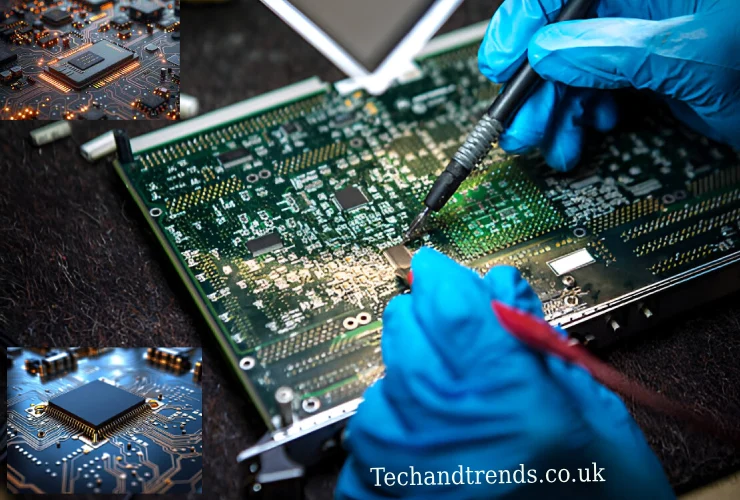Introduction: Why PCB Design Can Be Tricky for Newbies
Designing a printed circuit board (PCB) is an exciting step for anyone interested in electronics. However, it can be tricky for beginners because it requires both technical knowledge and practical skills. Many new designers feel overwhelmed by the many rules, software tools, and details involved. PCB Design for Beginners: mistakes made early on can lead to costly errors, delays, or even a board that doesn’t work at all.
But don’t worry! PCB design is a skill that anyone can learn with patience and practice. This article will guide you through common pitfalls and share easy tips to help you create your first PCB successfully.
Understanding the Role of a PCB in Electronics
A PCB is the foundation of almost every electronic device. It connects electronic components such as resistors, capacitors, and microchips by using copper traces on a non-conductive board. This replaces the messy and unreliable wiring of old-fashioned circuits.
The PCB not only connects components but also provides mechanical support and helps manage electrical signals efficiently. Without a well-designed PCB, your electronic device may fail to function properly or be difficult to assemble and repair.
Common Mistake #1: Ignoring Design Rules Early On
One of the biggest mistakes beginners make is ignoring design rules. These rules include minimum trace widths, spacing between traces, hole sizes, and component clearances. These are not arbitrary; they ensure your PCB can be manufactured and will work safely.
Ignoring these rules can cause short circuits, signal interference, or even damage your components. Before starting your layout, set up design rules in your PCB software. Many programs have default settings, but it’s best to check with your PCB manufacturer’s specifications.
Common Mistake #2: Poor Component Placement
Component placement is more than just putting parts on the board. Poor placement can make routing difficult and cause your circuit to perform poorly. For example, placing components too close together can cause soldering problems or heat buildup.
A good rule is to place components logically: group related parts, keep connectors near the board edges, and orient components in the same direction when possible. This makes your board easier to route and assemble.
Common Mistake #3: Inadequate Trace Widths and Spacing
Trace width and spacing are critical for current carrying capacity and preventing shorts. Beginners often use traces that are too thin or place traces too close together, especially in power or high-frequency sections.
Use online calculators or PCB software tools to determine the right trace width based on the current your circuit will carry. Always follow the minimum spacing guidelines to avoid electrical shorts and improve reliability.
| Read More |
|---|
| Starting a Lead Generation Business |
| DAB Premium Finance LLC |
| Chelsea Clinton Net Worth |
| Daniel Tosh Net Worth |
| Eric Roberts Net Worth |
PCB Design for Beginners: How to Plan Your Layout Wisely
Planning your PCB layout before you start is essential. Start with a clear schematic diagram that shows all your connections. Then, decide on the size and shape of your board.
Arrange components in a way that minimizes the length of critical signal paths. Keep power and ground traces wide and short to reduce noise. Leave space for connectors, mounting holes, and test points. Good planning saves time and reduces errors.
How to Avoid Overcomplicating Your First PCB Project
When you’re new, it’s tempting to add many features or try complex multi-layer boards. But this can lead to frustration and mistakes. For your first project, keep it simple: use a single-layer board if possible and focus on the basic functions.
Avoid fancy shapes or tight spacing that your manufacturer may not be able to handle. Simple designs are easier to debug and build your confidence.
Tips to Choose the Right Software for PCB Design
Choosing the right software is important for a smooth design experience. Beginners should look for tools that are easy to learn, have good documentation, and support exporting manufacturing files.
Free tools like KiCad and EasyEDA are popular choices because they offer powerful features without cost. If you want more advanced options, software like Altium Designer or Eagle may be suitable but can be expensive.
Try a few tools and choose one that fits your style and needs.
PCB Design for Beginners: Checking for Errors Before Printing
Before sending your design to be manufactured, always run a Design Rule Check (DRC). This automated check looks for errors such as overlapping traces, missing connections, or violations of spacing rules.
Also, manually review your design. Check component footprints against datasheets and ensure all pins are connected correctly. Confirm that your board size matches your project requirements.
Catching errors before manufacturing saves money and time.
Testing and Troubleshooting Your First PCB
Once your PCB arrives, start by inspecting it visually for defects like broken traces or solder mask problems. Use a multimeter to check continuity and ensure no shorts exist between power and ground.
When powering up, use a current-limited power supply if possible to prevent damage. Test each section of your circuit step-by-step.
If something doesn’t work, don’t panic. Troubleshooting is part of the learning process. Check solder joints, component orientation, and wiring carefully. Use tools like oscilloscopes or logic analyzers if available.
Conclusion: Your Roadmap to Confident PCB Design
Designing your first PCB may seem challenging, but by understanding the basics and avoiding common mistakes, you can succeed. Plan your layout carefully, choose the right software, and always check your work before manufacturing.
Remember, every expert was once a beginner. With practice and patience, you will gain confidence and skills to design more complex and exciting electronic projects. Start simple, learn from each design, and enjoy the rewarding process of bringing your ideas to life on a PCB!


Comments are closed.